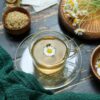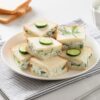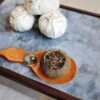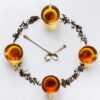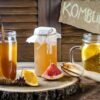
Step into the world of elegance and craftsmanship with the art of tea cups. From delicate porcelain to vibrant ceramics, the diverse range of designs and styles will transport you to a realm of beauty and sophistication.
Each tea cup tells a unique story, reflecting the culture and history of its origin. From the intricate hand-painted motifs of traditional Chinese tea cups to the minimalist elegance of Japanese ceramics, every piece is a work of art. Whether you prefer the classic charm of vintage tea cups or the contemporary flair of modern designs, there is a tea cup to suit every taste and occasion.
Explore the world of tea cups and discover the artistry behind their creation. Immerse yourself in the details of exquisite craftsmanship and learn about the techniques used to produce these stunning pieces. Uncover the symbolism and cultural significance behind the patterns and motifs, and gain insight into the artistic traditions that have been passed down through generations.
Join us on a captivating journey as we delve into the enchanting world of tea cups. Embark on a quest to find the perfect tea cup that resonates with your personal style and enhances your tea-drinking experience.
History of tea cups
Tea cups have a rich and fascinating history that dates back centuries. The origins of tea cups can be traced back to ancient China, where tea drinking was an integral part of the country’s culture. The earliest tea cups were simple bowls made from clay or stone, designed to hold hot tea. As tea drinking became more popular, artisans began to experiment with different materials and techniques, giving rise to a wide variety of tea cup designs.
During the Tang dynasty, tea drinking became more refined, and tea cups started to take on more elaborate forms. Porcelain tea cups adorned with intricate patterns and motifs became highly prized possessions among the elite. These tea cups were not only functional but also served as status symbols, showcasing the wealth and taste of their owners.
In Japan, tea drinking was heavily influenced by Zen Buddhism, which emphasized simplicity and mindfulness. Japanese tea cups, known as chawan, were typically made from rustic ceramics and had a more organic and natural aesthetic. The focus was on the experience of tea drinking rather than the visual appeal of the tea cups themselves.
Over time, tea cups began to spread to other parts of the world, including Europe and the Americas. Each region developed its own unique styles and designs, incorporating elements of their respective cultures into the art of tea cup making. Today, tea cups continue to evolve, with modern designers pushing the boundaries of creativity and innovation.
Different types of tea cups
Tea cups come in a wide range of shapes, sizes, and materials, each designed to enhance the tea-drinking experience in its own way. Here are some of the most popular types of tea cups you may come across:
1. Porcelain Tea Cups: Porcelain tea cups are known for their delicate beauty and translucent appearance. They are often adorned with intricate hand-painted designs or elegant patterns. Porcelain tea cups are prized for their ability to retain heat, making them ideal for enjoying hot teas.
2. Ceramic Tea Cups: Ceramic tea cups are versatile and come in a variety of styles and colors. They can be glazed or unglazed, and their thick walls help to keep the tea warm for longer periods. Ceramic tea cups are durable and can withstand high temperatures, making them suitable for both hot and cold teas.
3. Glass Tea Cups: Glass tea cups are prized for their transparency, allowing you to appreciate the color and clarity of the tea. They are often used for showcasing the visual beauty of flowering teas or herbal infusions. Glass tea cups are also heat-resistant, making them suitable for both hot and iced teas.
4. Stoneware Tea Cups: Stoneware tea cups are known for their rustic charm and earthy appeal. They are typically handcrafted and feature unique glazes and textures. Stoneware tea cups have excellent heat retention properties, keeping your tea warm for longer periods.
5. Bamboo Tea Cups: Bamboo tea cups are a traditional choice in many Asian cultures. They are lightweight, eco-friendly, and have natural insulating properties. Bamboo tea cups are often used for enjoying green teas, as they help to enhance the natural flavors of the tea.
Famous tea cup designers and their signature styles
Throughout history, there have been many influential tea cup designers who have left their mark on the world of tea cups. Their unique styles and artistic vision have shaped the way we perceive and appreciate these exquisite pieces. Here are a few famous tea cup designers and their signature styles:
1. Jingdezhen Porcelain: Jingdezhen is renowned for its production of high-quality porcelain tea cups. The city has a long history of porcelain making, and its craftsmen are known for their exceptional skills and attention to detail. Jingdezhen porcelain tea cups often feature intricate hand-painted motifs, such as landscapes, flowers, and dragons.
2. Yixing Teaware: Yixing teaware is famous for its unglazed clay tea cups, known as Yixing teapots. These tea cups are made from a unique type of clay found in the Yixing region of China. Yixing clay is highly porous and believed to enhance the flavor of the tea. Yixing tea cups are often adorned with simple yet elegant designs, focusing on the natural beauty of the clay.
3. Kyo-yaki: Kyo-yaki is a style of Japanese ceramics that originated in Kyoto. Kyo-yaki tea cups are known for their minimalist elegance and refined aesthetics. They often feature soft colors and delicate brushwork, inspired by traditional Japanese art forms such as calligraphy and painting.
4. Wedgwood: Wedgwood is a British pottery company that has been producing fine ceramics since the 18th century. Wedgwood tea cups are characterized by their classical elegance and timeless appeal. They often feature intricate patterns, such as floral motifs or geometric designs, and are crafted with meticulous attention to detail.
Collecting tea cups as a hobby
Collecting tea cups can be a rewarding and enjoyable hobby. Each tea cup has its own unique story to tell and can provide insights into different cultures and time periods. Here are some tips for starting your own tea cup collection:
1. Research and Learn: Spend time researching different styles, designs, and historical periods of tea cups. This will help you develop an understanding of the various types of tea cups and their significance.
2. Visit Antique Shops and Flea Markets: Antique shops and flea markets are treasure troves for tea cup collectors. You may come across rare and unique pieces that are not easily found elsewhere. Be sure to inspect the tea cups carefully for any damage or restoration.
3. Attend Tea Cup Exhibitions and Fairs: Tea cup exhibitions and fairs are great places to learn more about tea cups and connect with other collectors. You can view a wide range of tea cups and even make new additions to your collection.
4. Join Online Communities: Joining online communities and forums dedicated to tea cup collecting can provide valuable insights and resources. You can connect with experienced collectors, share your collection, and learn from others.
5. Display and Care for Your Collection: Once you have started your collection, consider how you will display and care for your tea cups. Display cabinets or shelves with proper lighting can showcase your tea cups beautifully. Be sure to handle them with care and follow the recommended cleaning and maintenance guidelines.
How to choose the perfect tea cup for your needs
Choosing the perfect tea cup for your needs is a personal and subjective decision. Here are some factors to consider when selecting a tea cup:
1. Comfort and Size: Consider the size and shape of the tea cup. Ensure that it fits comfortably in your hand and that the handle is easy to grip. The size of the tea cup should be suitable for the type of tea you prefer to drink.
2. Material: Decide on the material you prefer for your tea cup. Each material has its own unique characteristics, such as heat retention, transparency, or durability. Choose a material that aligns with your preferences and the type of tea you enjoy.
3. Design and Style: Consider the design and style of the tea cup. Do you prefer a classic and timeless design, or are you drawn to more contemporary and bold patterns? Find a tea cup that resonates with your personal taste and complements your tea-drinking experience.
4. Cultural Significance: If you are interested in the cultural significance of tea cups, look for designs and motifs that reflect the traditions and symbolism of different cultures. This can add another layer of meaning and appreciation to your tea-drinking ritual.
5. Price and Budget: Set a budget for your tea cup purchase. Tea cups can range in price from affordable to luxurious. Decide how much you are willing to invest in your tea cup collection and explore options within your budget.
Unique and unusual tea cup designs
Tea cups can be a canvas for creativity and innovation, resulting in unique and unusual designs that break away from tradition. Here are a few examples of tea cup designs that push the boundaries of conventional aesthetics:
1. Double-Walled Tea Cups: Double-walled tea cups are designed to keep the tea hot while remaining cool to the touch. The outer layer acts as insulation, keeping the heat inside, while the inner layer allows you to see the color of the tea.
2. Animal-Shaped Tea Cups: Animal-shaped tea cups add a whimsical touch to tea drinking. These cups can be shaped like animals such as cats, rabbits, or birds, and often feature intricate details and vibrant colors.
3. Interactive Tea Cups: Interactive tea cups are designed to engage the senses and create a unique tea-drinking experience. They may include elements such as built-in strainers, hidden compartments, or special mechanisms that enhance the brewing process.
4. Textured Tea Cups: Textured tea cups are crafted with intricate patterns and textures, adding a tactile dimension to the tea-drinking experience. These cups are often handcrafted and can feature embossed designs or raised surfaces.
Care and maintenance of tea cups
Proper care and maintenance are essential to preserve the beauty and longevity of your tea cups. Here are some tips to keep your tea cups in pristine condition:
1. Handwashing: Most tea cups are delicate and should be hand washed to avoid any damage. Use mild dish soap and warm water to gently clean the tea cups. Avoid using abrasive materials or harsh chemicals.
2. Drying: After washing, allow the tea cups to air dry or use a soft cloth to gently pat them dry. Avoid using high heat or placing them in direct sunlight, as this can cause the tea cups to fade or crack.
3. Storage: Store your tea cups in a cool and dry place, away from direct sunlight or extreme temperatures. Wrap each tea cup in soft cloth or tissue paper to protect them from scratches or chips.
4. Handling: When handling tea cups, be mindful of their delicate nature. Hold them by the handle or use both hands to support the cup. Avoid placing excessive pressure or force on the tea cups, as this can cause them to break or chip.
5. Regular Inspections: Regularly inspect your tea cups for any signs of damage or wear. Look for cracks, chips, or discoloration. If you notice any issues, consult a professional for repairs or restoration.
Where to buy tea cups – online and offline options
There are numerous options for purchasing tea cups, both online and offline. Here are a few places where you can find a wide variety of tea cups:
1. Tea Specialty Stores: Tea specialty stores often carry a selection of tea cups, ranging from traditional to contemporary designs. These stores may also offer guidance and recommendations based on your preferences and needs.
2. Antique Shops and Vintage Stores: Antique shops and vintage stores are excellent sources for unique and collectible tea cups. You may find vintage tea cups with intricate designs or rare pieces that are no longer in production.
3. Online Marketplaces: Online marketplaces such as Amazon, eBay, and Etsy provide a wide range of tea cups from various sellers. You can explore different styles, compare prices, and read reviews from other buyers.
4. Auctions and Estate Sales: Auctions and estate sales can be a treasure trove for tea cup collectors. These events often feature unique and valuable pieces that may not be available elsewhere.
5. Directly from Artists and Designers: Many artists and designers create one-of-a-kind tea cups that can be purchased directly from their websites or at craft fairs and exhibitions. Buying directly from the artist allows you to support their work and have a more personal connection to the tea cup.

